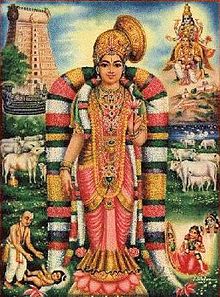Andal | |
|---|---|
 Painting of Andal | |
| Personal | |
| Born | Kothai 7th century CE |
| Religion | Hinduism |
| Spouse | Rangamannar as Ranganatha (according to Sri Vaishnava tradition) |
| Parent |
|
| Organization | |
| Philosophy | Sri Vaishnavism |
| Religious career | |
| Reincarnation | Bhudevi (according to Sri Vaishnava tradition), Vijaya Lakshmi, MahaLakshmi |
| Literary works | Tiruppavai, Nachiyar Tirumoli |
| Part of a series on |
| Vaishnavism |
|---|
 |
Andal (Tamil: ஆண்டாள்; ISO 15919: Āṇḍāḷ), also known as Kothai, Nachiyar, and Godadevi, was the only female Alvar among the twelve Hindu poet-saints of South India. She was posthumously considered an avatar of the goddess Bhudevi. As with the Alvar saints, she was affiliated with the Sri Vaishnava tradition of Hinduism. Scholars believe her to have been active in the 8th-century CE,[1][2] with some suggesting 7th century CE.[3][note 1]
Andal is credited with two great Tamil works, Tiruppavai and Nachiyar Tirumoḻi, which are still recited by devotees during the winter festival season of Margaḻi. Andal is a prominent figure for women in South India and has inspired several women's groups, such as Goda Mandali.[5]
- ^ Bryant, Edwin Francis (2007). Krishna: A Sourcebook. Oxford University Press. p. 188. ISBN 978-0-19-803400-1.
- ^ Chitnis, Krishnaji Nageshrao (2003). Medieval Indian History. Atlantic Publishers & Dist. p. 116. ISBN 978-81-7156-062-2.
- ^ a b S. M. Srinivasa Chari (1 January 1997). Philosophy and Theistic Mysticism of the Āl̲vārs. Motilal Banarsidass. pp. 11–12. ISBN 978-81-208-1342-7.
- ^ Greg Bailey; Ian Kesarcodi-Watson (1992). Bhakti Studies. Sterling Publishers. ISBN 978-81-207-0835-8.
- ^ Cite error: The named reference
Pintchmanwas invoked but never defined (see the help page).
Cite error: There are <ref group=note> tags on this page, but the references will not show without a {{reflist|group=note}} template (see the help page).